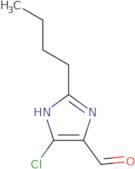
2-Butyl-4-chloro-1H-imidazole-5-carboxaldehyde
CAS: 83857-96-9
Ref. 3D-FB19493
| 25g | 192,00 € | ||
| 50g | 288,00 € | ||
| 100g | 434,00 € | ||
| 250g | 737,00 € | ||
| 500g | 1.039,00 € |
Produktinformation
- 2-Butyl-5-chloro-1H-imidazole-4-carboxaldehyde2-Butyl-4-chloro-5-formylimidazole2-Butyl-4-chloroimidazole-5-carboxaldehyde
- (2-n-Butyl-5-Chloro-imidazole-4-yl)-Carboxaldehyde
- 1H-Imidazole-4-carboxaldehyde, 2-butyl-5-chloro-
- 2-Butyl-4-Chloro-1H-Imidazole-5-Carbaldehyde
- 2-Butyl-4-Chloro-1H-Imidazole-5-Carboxaldehyde
- 2-Butyl-4-Chloro-1H-imidazo-5-Carboxaldehyde
- 2-Butyl-4-Chloro-5-Imidazole Carboxaldehyde
- 2-Butyl-4-Chloro-5-Imidazolecarboxaldehyde
- 2-Butyl-4-Chloro-5-formyl imidazole
- 2-Butyl-4-Chloro-5-formylimidazloe
- Mehr Synonyme anzeigen
- 2-Butyl-4-Chloro-5-formylimidazole
- 2-Butyl-4-Chloro-Imidazole-5-Carbaldehyde
- 2-Butyl-4-chloro-1-H-imidazole-5-carboxaldehyde
- 2-Butyl-4-chloro-1H-imidazolyl-5-carboxaldehyde
- 2-Butyl-4-chloro-5-formylimidazole(BCFI)
- 2-Butyl-4-chloroimidazole-5-carbaldehyde
- 2-Butyl-4-chloroimidazole-5-carboxaldehyde
- 2-Butyl-5-Chloro-1H-Imidazole-4-Carbaldehyde
- 2-Butyl-5-Chloroimidazole-4-Carboxaldehyde
- 2-Butyl-5-chloro-3H-imidazole-4-carboxaldehyde
- 2-Butyl-5-chloro-4-formylimidazole
- 2-Butyl-5-chloroimidazole-4-carbaldehyde
- 2-Butyl-5-formyl-4-chloroimidazole
- 2-n-Butyl-4-Chloro-1H-Imidazole-5-Carboxaldehyde
- 2-n-Butyl-4-chloro-5-imidazolecarboxaldehyde
- 2-n-Butyl-5-chlorimidazole-4-carbaldehyde
- 4-Chloro-2-n-butylimidazole-5-carboxaldehyde
- Bcfi
- 2-Butyl-5-chloro-1H-imidazole-4-carboxaldehyde
Glyoxal is a chemical compound that has shown to have bactericidal activity against human pathogens such as Mycobacterium tuberculosis, Helicobacter pylori, and Staphylococcus aureus. It is used in the synthesis of heterocyclic amines and can be found as an impurity in imidazole derivatives. Glyoxal is a broad-spectrum antimicrobial that has been shown to inhibit the growth of fungi and bacteria by reacting with functional groups on the microorganisms' cell walls. It reacts with bacterial cell walls by forming an intermediate molecule, which reacts with other molecules present in the microorganism's environment to form carbon dioxide, water, and glyoxal. The reaction time for glyoxal depends on temperature; higher temperatures will result in faster reactions. Techniques used to synthesize glyoxal include dehydration of oximes or by reaction with phosphorus oxychloride.
Chemische Eigenschaften
Technische Anfrage zu: 3D-FB19493 2-Butyl-4-chloro-1H-imidazole-5-carboxaldehyde
Wenn Sie ein Angebot anfordern oder eine Bestellung aufgeben möchten, legen Sie stattdessen die gewünschten Produkte in Ihren Warenkorb und fordern Sie dann ein Angebot oder eine Bestellung an aus dem Warenkorb. Es ist schneller, billiger und Sie können von den verfügbaren Rabatten und anderen Vorteilen profitieren.





